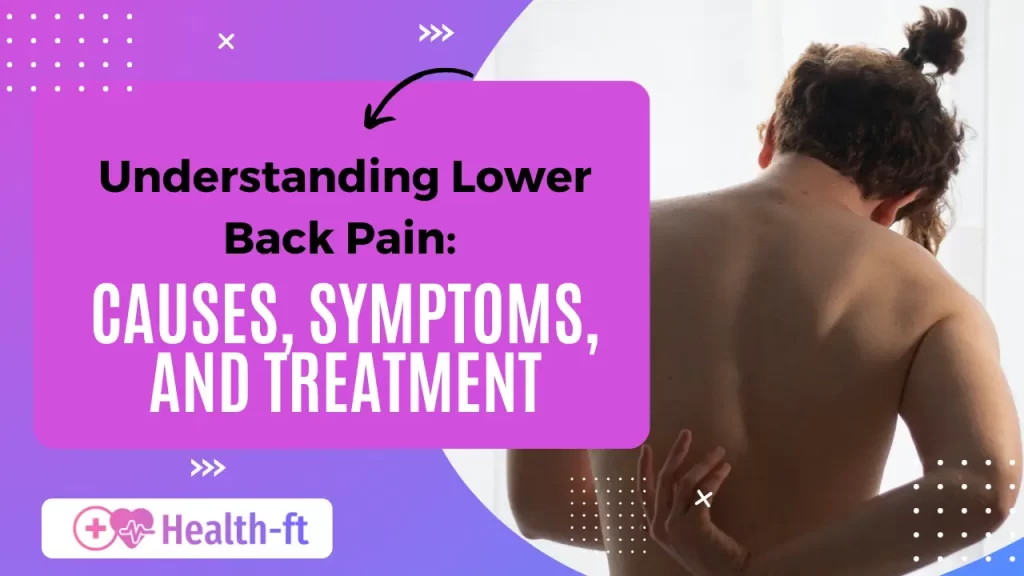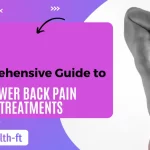Lower Back Pain is without doubt one of the world’s most frequent complaints of people of all ages and sexes. Whether it is a ’mobile’ pain or persistent and constant pain, it hinders one’s functioning and quality of life. Pain in the lower back may be due to a number of causes among them being muscle strain, and other complications. In this article, we are going to be looking at the main reasons for lower back pain and this include, lower back muscle pain, causes of back pain in females and particular situations such as, lower right back pain.
What Causes Lower Back Pain?
Backache is a symptom and not a disease specifically referring to the lower back. This may result from lifestyle factors but may also be due to medically rooted causes. This pain may be acute – it comes and goes in a short period, or it may be chronic – that has developed over some time. Here are some common lower back pain causes:
Muscle Strain and Ligament Sprain
The more common reasons of lower back pain include muscle strain or ligament sprain Frequently it is called a ‘pulling away’ of the back muscles. These injuries can be caused by improper lifting, any twist or turn, or over stressing during exercises. Muscle sprain is a condition arising from over stretching of the muscles in the lower back causing inflammation, pain and tightness.
Poor Posture
Sitting with a bad posture or standing or walking with bad posture places immense pressure to the lower back muscles and spine. They place constant pressure and eventually cause some mild pain, which in the long run, can result in chronic lower back pain. Sitting for long hours with a wrong posture complements the problem say while using an office chair or while driving a car.
Herniated or Slipped Disc
Slipped disc on the other hand refers to a situation where the cushion between two bones in the spine is displaced or protrudes and may be squashing nerves nearby. This can lead to severe stabbing pain in the lower back and might go down to the legs if it’s sciatica. Disc herniations are more typical in elderly people although it can afflict anyone that lifts hefty objects or performs physically demanding work persistently.
Degenerative Disc Disease
With time, the discs in the spinal column can degenerate, losing their ability to act as efficient shock absorbers. This biochemical wear and tear can result in backache, particularly in older adults. Smoking can further accelerate this process by restricting blood flow to the spinal discs, depriving them of essential nutrients, and increasing the risk of degenerative disc disease. As a result, individuals may experience chronic pain, stiffness in the lower back, and reduced flexibility.
Arthritis
Lower back pain may also result from osteoarthritis, a condition where joint cartilage degenerates and eventually disappears. This is common among the elderly and may lead to complications such as stiffness and joint movement limitations. Osteoarthritis can affect multiple joints, including causing knee pain and mobility issues that further impact posture and spinal alignment. The arthritis in the lower back may also cause the growth of bone spurs, which put pressure on the spinal nerves, leading to additional discomfort.
Sciatica
Sciatica is an ailment in which the nerve that starts at the lower back and splits into two nerves down the legs- Sciatic nerve is compressed. This compression can be due to a slipped disc, bone outgrowth, or spinal stenosis—the narrowing of the canal through which the spinal nerves pass. Sciatica is characterized by a burning, electric-type pain that emanates from the lower back through the buttock and down the leg, into the foot on one side of the body.
Spinal Stenosis
Spinal stenosis is now defined as the process through which the spinal canal in the lower back becomes narrowed and exerts pressure on the nerves. It is also found more frequently in people with advanced age and has manifestations that include but are not limited to lower back pain and numbness and weakness of the legs.
Scoliosis
Scoliosis means the side shape of the vertebrae and could create uneven stress within the lower spine. Depending on the level of scoliosis, one may not even feel the pain while on the other extremity, the severe scoliosis causes lower back pain that may need treatment.
What Are The Causes of Lower Back Pain in Females
Pain in the lower back in women may be due to other factors that may be hormonally associated with reproductive organs. Specific subtypes of lower back pain more commonly occur in women because of anatomical and physiological factors. Here are some of the particular Lower back pain causes in females:
Menstrual Cycle-Related Pain
A research showed that a considerable number of women suffer from lower back pain during their menstruation. Such pain is always linked to the changes in hormones especially during the periods of menstruation. Some chemicals referred to as prostaglandins that are produced during menstruation can make the uterus contract and cause cramps and pain that can extend to the lower back.
Pregnancy
Pregnancy creates extra stress on the lower back as a direct result of the weight of the fetus as well as the change of the body’s balance. During pregnancy, muscles and ligaments in the lower back are strained because the weight of the uterus increases. Moreover, because the hormone relaxin is also responsible for ligament relaxation within the pelvic region, low back pain is also associated with pregnant women due to ligament laxity.
Endometriosis
Endometriosis is an illness in which endometrial-like tissue is present in locations outside of the uterus. This leads to back pains particularly during those special days of the month, menstrual days. It may also be severe and may be long lasting in a way that will limit the activity level of a woman.
Polycystic Ovary Syndrome (PCOS)
PCOD is a hormonal disorder which has the potential to cause lower backache to women. The condition is frequently described as pelvic pain, which can be further accompanied by low back pain. Also, overweight, a characteristic of PCOS, can aggravate further the tension of the lower back muscles.
Pelvic Inflammatory Disease (PID)
PID is an infection of the female reproductive organs and it can cause a woman to have backaches especially in the lower back. The infection may also travel up from the pelvis to the lumbar area leading to discomfort and pain. PID comes hand in hand with other signs like abnormal vaginal discharge, fever and pain during sexual intercourse.
What Does Lower Right Back Pain Mean?
Lower right back pain is a subcategory of lower back pain which can be of different causes. Pain location might give some hints of its origin in the human body. You know, the location of the pain can tell you what could have caused it.
Here are some possible reasons for experiencing pain in lower right back:
Muscle Strain or Injury
Similar to general lower back pain, a muscle strain or any form of injury in the right side of the lower back results to localized right lower back pain. This may be as a result of carelessness in the use of the organs, lifting of heavy objects, or by placing the organs in an awkward twisting position. The pain is often described as stabbing and is likely to be aggravated by any kind of motion.
Kidney Problems
The kidneys are positioned in the lower back and…this pain may be due to a kidney problem, for example a kidney infection or stones. Renal pain is localized in the flank, which is the curved area at the sides of the back, and maybe associated with such signs as fever, nausea, and changes in the urinary process.
Appendicitis
Nevertheless, that ordinary appendicitis pains in the lower right abdomen and the discomfort can spread to the lower back. Appendicitis is a medical emergency whereby other symptoms like nausea vomiting and fever usually accompany the abdominal pain.
Spinal Issues
A herniated disc or spinal stenosis can also be the reason for pain limited to a certain area of the lower back, including the right side. The pain may spread down to the legs if the condition is affecting the sciatic nerve.
Gallbladder Problems
It is to emphasize that a number of conditions, including gallstones, related to the gallbladder can produce referred right lower back ache. This type of pain is normally localized in the upper right abdomen but may radiate to the lower right abdomen or back. Appendicitis causes sharp pain in your lower right abdomen that can radiate to your belly and your back, often after eating gas-producing foods.
How to Treat and Manage Lower Back Pain?
The treatment for lower back pain depends on its underlying cause. Here are some common treatment approaches:
Rest and Ice/Heat Therapy
In case of muscle strains and sprains you should avoid using of the damaged area and you can apply an ice pack or hot towel on it to decrease inflammation and pain. Whereas the first 48 hours, ice is advised to immobilise the area and reduce inflammation, heat is used to help denature any contracted muscles.
Physical Therapy
This is usually prescribed for increasing the tone of muscles in the lower back and for correcting posture. This means that particular exercises associated with exercises that seek to strengthen the core muscles may help support the spine in the future more than they do currently.
Pain Medications
Muscle pain in the lower back also can be eased using over the counter drugs like ibuprofen or acetaminophen. Sometimes it may become even worse and the doctor may decide to increase the dosage of the medicines or administer the muscle relaxant drugs.
Chiropractic Care
Chiropractic adjustments may assist in reducing lower back pain in a patient by adjusting their spine and increasing the range of their motion. It also seems beneficial to patients with certain diseases, for example, sciatica or a herniated disc.
Lifestyle Modifications
Lower back pain can be prevented and managed through measures such as maintaining a healthy weight exercising, and maintaining a good posture. That is why it is necessary not to sit, for example, for an hour, and immediately stand, as well as it is possible to work at an ergonomic table.
Health Tracking for Back Pain Management
Tracking overall health metrics can also be beneficial in identifying risk factors early; using tools to calculate health can help assess body weight, BMI, and other vital indicators.
Surgical Intervention
In some special, rare conditions, lower back pain may originate from a herniated disc or spinal stenosis and might require surgery. Surgery is usually the last measure that is usually taken when all other treatments can hardly help out.
Conclusion
Lowers back pain is a multifactorial complaint which can be caused by factors such as muscle strain, poor posture, disc degeneration, and some diseases exclusive to women like endometriosis and PCOS. Lower right back pain can be due to muscle strain, kidney disease or even appendix inflammation. In order for the professional to recommend the most effective treatment, one has to identify the cause of the lower back pain. One should not take too much or severe lower back pains lightly and should seek medical help to determine the cause and seek remedy.




